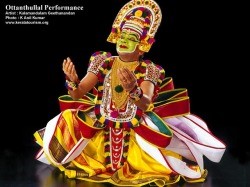Description

Disclaimer: Copyright infringement not intended.
Context: Masters lament that students drop learning the art form after school days.
Details:
About:
- A solo dance exposition, the Thullal is of three types.
- Its origin is attributed to Kunchan Nambiar, a veritable genius and one of the foremost poets of Kerala.
- Though based on the classic principles of Natya Shastra the technique of this art is not rigid.
- The songs, written in simple Malayalam, frank to outspoken wit and humor, the simplicity of presentation and the direct appeal to everyday life made Thullal very popular.
- The instruments used in Thullal are the mandala and the cymbals.
- The cymbal player who tunes the rhythm also assists the actor-dancer (Thullakaran) in singing.
Performance:
- In actual performance, the cymbal player first sings the invocation song when the dancer faces the orchestra and does obeisance.
- After that, with his back still to the audience the dancer does a slick flourish of step and body movements. Then he turns to the audience and the dance proper is begun.
- He first sings a verse and while the lines are being repeated by his musical assistance, he brings out the meaning through facial expressions, hand gestures and bodily postures.
- The roles of the raconteur and actor are perpetually interchanged with tremendous aesthetic efforts.
- In one moment he is the narrator but in the next, he completely identifies himself with the narration. It is to the dance that prime importance is given in Thullal.
- From the beginning to the end there is dance even though it lacks much of variety. To compensate for the monotony, sometimes the dancer executes some vigorous footsteps and rhythmic movements of the body.
.jpeg)
Types:
Thullal is classified as Ottan, Seethankan and Parayan based on the difference in costume, dance and also the metre and rhyme of the Thullal songs.
Ottan Thullal
- Of all Thullal dances the Ottan Thullal is the most popular.
- The costume is peculiar and impressive.
- A long tape of cloth of white and red colour is hooked around a waist string to form a knee length skirt. A chest plate adorned with various types of coloured beades, glass and tinsel and ornaments is also used.
- Gaudily painted wooden ornaments are worn at the wrist, and on the shoulders.
- Tinkling bells are tied to the legs just above the calf. The face is painted green, the lips are reddened and the eyes are emphasised with black paint.
- The head -dress is colourfully decorated.
- The metre and rhyme of the Ottam Thullal songs are very fast, and the dance as such has a high tempo.
Sheethankan Thullal
- In Seethankan Thullal the metre and rhyme of the Thullal songs are a bit more- slow than in Ottam Thullal and consequently dance is also slower in tempo.
- The dancer uses similar skirt as in Ottam Thullal.
- But the arms, wrists and head are adorned with ornaments made of fresh tender coconut fronds. There is no facial make up except darkening of the eyes.
Parayan Thullal
- The Parayan Thullal is the slowest in tempo.
- Even the stance of the dancer is different from the other two.
- Here the dancer almost stands erect and explains the meaning of the songs by gestures.
- There is very little of the dance element or of action. The costume is also different.
- A red, flowery clothing is worn around the waist. A crown of black cloth adorns the head. Necklaces are used on the chest. The face is painted with light yellow.
.jpeg)
https://www.thehindu.com/news/national/kerala/kerala-school-kalolsavam-2023-the-need-to-take-ottanthullal-forward/article66343344.ece















